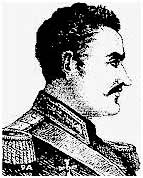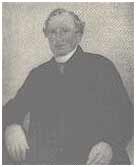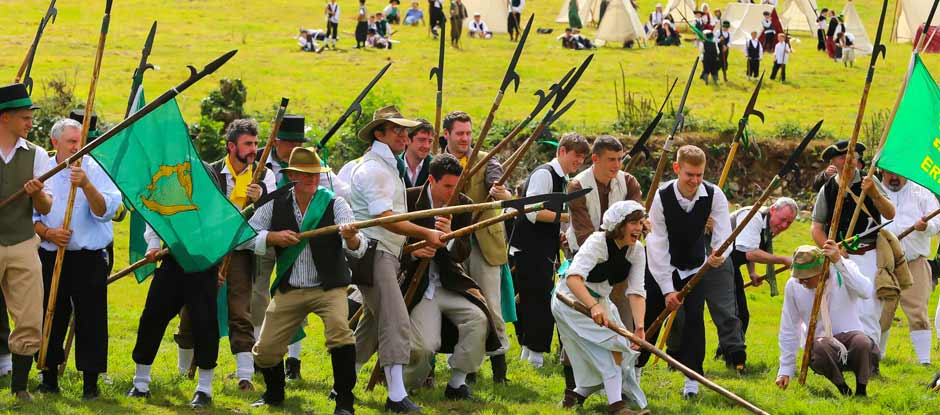Irish Leaders
Irish leaders included: Miles Byrne, Thomas Cloney of Moneyhore, John Henry Colclough, Edward Fitzgerald, Cornelius Grogan, Bagenal Harvey, Fr. Mogue Kearns, John Kelly “of Killanne”, General Gerard Lake, General Sir John Moore, Fr. John Murphy, Fr. Michael Murphy, Anthony Perry, and Fr. Philip Roche.
Miles Byrne

Born in Ballylusk, Monaseed, Co, Wexford in 1780.
Joined the United Irishmen in 1797, apparently influenced by Anthony Perry of Inch. Byrne participated in the Rebellion at Bunclody Tubberneering, Arklow and Vinegar Hill. Accompanied Fr. John Murphy on the advance to and retreat from Castlecomer, Co. Kilkenny. Continued in the field until the end, eventually escaping to Dublin where he remained undetected, employed as a builder from 1799 to 1803.
Met Robert Emmet in Dublin and became one of his faithful lieutenants. After the failure of the Emmet’s Rising (1803) he escaped to Paris.
Commissioned as an infantry officer in the Irish Legion. Fought in the Napoleonic wars where he had a very distinguished career. Died in Paris in 1862. His “Memoirs” were published by his widow in 1863. They include a valuable account of the 1798 rising in Wexford.
Anthony Perry
Son of Denis Cloney, a well-to-do farmer from Moneyhore, Co. Wexford. Twenty-six years old at time of rebellion. Later claimed he was not a United Irishman, and had been an unwilling insurgent.
Played a leading and distinguished part in the action against General Fawcett’s advance guard below Three Rocks and at New Ross. Cloney served under Father Philip Roche at Lacken Hill, Wexford and Goff’s Bridge (Foulksmills).
Both he and Father Kearns went into hiding at his father’s house for a time. In June 1799 Cloney was arrested and jailed in Wexford, court-martialed on a charge of accessory to murder, found guilty and sentenced to death. Lord Cornwallis reduced the sentence to two years in exile. He went to England for the duration of his exile and returned to Ireland in February 1803 taking up residence in Graiguenamanagh.
He died there on 20th February 1850 at the age of seventy six. He was author of the book, “A Personal Narrative 1798”, published in 1832.
Other Leaders Included:
John Henry Colclough
Lived in Ballyteigue, Kilmore, Co. Wexford.
Landowner, a man of liberal principles, and a qualified doctor. Considered to have been an unwilling rebel. Arrested on 27th May 1798 and brought to Wexford gaol (jail).
Sent by Government forces, with Edward Fitzgerald, to speak with the rebels at Vinegar Hill on 29th May, and allowed to return to report that the negotiations had failed. Colclough was in the area of New Ross and Goff’s Bridge (Foulksmills) around the time of the battles, but did not fight. Sources suggest this was not due to lack of courage but because he did not wish to become too involved.
While negotiations were taking place on 21st June, Colclough returned home to Ballyteigue. Later he, his wife and Bagenal Harvey were arrested on the Greater Saltee Island and court-martialled. Colclough was hanged on 28th June, 1798.
Edward Fitzgerald
Born in or around 1770, he lived at Newpark, near Blackwater. On 26th May, the local magistrate, Edward Turner, agreed to protect local people who gave up their weapons, and many people met at Fitzgerald’s house to hand over their arms. The next day, the High Sheriff arrested Fitzgerald and jailed him in Wexford. On the 29th May, Fitzgerald agreed to act as “go-between” for the government troops in Wexford and the rebels on Vinegar Hill.
Detained by the rebels there, he became one of their leaders, although some continued to question his loyalty when he left Wexford to visit his home at Newpark.
When Wexford rebels were scattered in County Meath, he surrendered to General Dundas on 12th July on condition that he left Ireland, but was held in Dublin Castle for nearly six months. Finally he went to Hamburg, Germany where he died in 1807.
Cornelius Grogan
A wealthy landowner who lived at Johnstown Castle.
High Sheriff of the County and represented Enniscorthy in the Irish parliament from 1783 to 1790.
A Protestant landowner, he held liberal principles and was an advocate of reform and emancipation. When the rebel garrison retreated from Wexford town he tried to escape to Duncannon but was prevailed upon by some to return to Wexford town.
Captured and charged at his trial with having been present at the battle of New Ross. His house was seized by troops and his property taken.
At his court martial he protested his loyalty and claimed he was forced to take part in the Rising. Executed on 28th June 1798.
His younger brother Thomas Grogan Knox was killed at Arklow serving with Castletown Yeoman Cavalry, and another brother, John Grogan, was wounded with the Healthfield Yeomanry.
Bagenal Harvey
Lived in Bargy Castle, and was a lawyer and member of the United Irishmen.
A man of liberal principles, he supported the ideal of government reform and emancipation.
Arrested at his house at 11.00 p.m., 26th May, (on information given by Anthony Perry under torture), and lodged in Wexford gaol. Remained in Wexford until its occupation by insurgents, whereupon appointed Commander-in-Chief, probably against his will.
Aged 36 at the time, he was in command at the battle of New Ross, which ended in defeat for rebels, and was overwhelmed by this disaster and the massacre at Scullabogue the same day. On 7th June he was replaced as Commander-in-Chief by Fr. Philip Roche and returned to Wexford where he was appointed President of the town committee. Apparently confident that a treaty would be negotiated by Lord Kingsborough, he retired to Bargy Castle. Shortly afterwards, accompanied by John Henry Colclough, he made his way to a cave on the Greater Saltee Island where they planned to escape to France by sea.
Betrayed and arrested, he was brought back to Wexford and hanged on the bridge on 28th June 1798.
Fr. Mogue Kearns
Born in Kiltealy into a farming family.
According to a story current in 1798, Kearns was a student in Paris at the height of the French Revolution and was hanged from a lamp-post by the mob. However, the weight of his body bent the lamp-post and his toes touched the ground. He was then rescued by a doctor who brought him back to consciousness.
After his ordination, was appointed curate at Balyna, on the Kildare-Meath border. He was not long in the parish when he was found to be politically active and dismissed by Bishop Delaney.
On his return from Kildare, he took up residence in Enniscorthy. Kearns joined the Insurgents from the outset and was prominent in the first battle of Enniscorthy on 28th May. From the camp at Vinegar Hill, Kearns led a detachment of 2,000 poorly-armed insurgents northwards to attack the garrison at Bunclody. On the morning of 1st June, they halted outside the town. Kearns ignored the advice of Miles Byrne to send a detachment to the Carlow road to cut off the garrison’s retreat and ordered the attack to begin. The garrison retreated, but, meeting reinforcements, returned and counter-attacked. The insurgents suffered heavy losses and retreated to Enniscorthy.
In the battle of Enniscorthy and Vinegar Hill, Kearns again played a prominent part but was wounded and had to be carried by the retreating insurgents towards Wexford.
Kearns took refuge until his wound had healed and then joined a large number of insurgents who were hiding in Killoughram Woods.
John Kelly “of Killanne”
Best remembered in the ballad by P. J. McCall, ‘Kelly the Boy from Killanne’. Both friends and foes admired him as brave and good, but there are few historical facts about Kelly.
He served in the rebel army for no more than a week and fought twice. He and the men of Killanne marched through The Leap to the camp at Vinegar Hill on 29th May after the battle at Enniscorthy.
One of the leaders who led the rebels from Three Rocks.
Fought and was badly wounded at Three Bullet Gate, Battle of New Ross and brought to Wexford.
Remained there until General Lake entered the town, when tried by court martial and hanged.
Fr. John Murphy

Studied for the priesthood in Spain, and returned to Ireland in 1785 as curate at Boolavogue. In 1797, many Catholic clergymen swore allegiance (or loyalty) to the British Crown, and encouraged local people to give up their weapons, and in return, receive “protections” from the government. However many people had to leave their homes to avoid persecution by the Yeomanry. This is said to have driven Fr. Murphy into the rebellion.
On 27th May, Fr. Murphy led a large group of pikemen and defeated a party of government troops at Oulart. The next day he took Camolin and Enniscorthy, and encamped on Vinegar Hill.
After defeats at Arklow and Vinegar Hill, Fr. Murphy joined a rebel group that passed through Scollagh Gap. They crossed the river Barrow and were defeated at Kilcumney.
Fr. Murphy went to Tullow where he was arrested, and executed there with James Gallagher on 2nd July, 1798.
Fr. Michael Murphy
Born in either Ballinoulart, Castleannesley or Kilnew, County Wexford, and educated at a hedge school in Oulart. Ordained at Wexford in 1785, and the following autumn went to France.
Upon return from France he become parish priest of Ballycanew, and according to Richard Musgrave “behaved himself with very great propriety ‘til the rebellion broke out.” Reputed to have joined the rebellion when his church was ransacked by the yeomen on 27th May. Travelled to Gorey and then to Kilthomas Hill, and joined Fr. John Murphy on Ballyorril Hill. Fr. Michael Murphy was killed at the battle of Arklow on June 9th 1798 leading an attack on a gun position which defended the western approach to the town. Buried at Castle Ellis.
Thomas Cloney of Moneyhore
Son of Denis Cloney, a well-to-do farmer from Moneyhore, Co. Wexford. Twenty-six years old at time of rebellion. Later claimed he was not a United Irishman, and had been an unwilling insurgent.
Played a leading and distinguished part in the action against General Fawcett’s advance guard below Three Rocks and at New Ross. Cloney served under Father Philip Roche at Lacken Hill, Wexford and Goff’s Bridge (Foulksmills).
Both he and Father Kearns went into hiding at his father’s house for a time. In June 1799 Cloney was arrested and jailed in Wexford, court-martialed on a charge of accessory to murder, found guilty and sentenced to death. Lord Cornwallis reduced the sentence to two years in exile. He went to England for the duration of his exile and returned to Ireland in February 1803 taking up residence in Graiguenamanagh.
He died there on 20th February 1850 at the age of seventy six. He was author of the book, “A Personal Narrative 1798”, published in 1832.
Fr. Philip Roche
Born in Monagrena near Boolavogue, Monageer about 1760, he was ordained in Wexford by Bishop Caulfield on 17th May, 1785. His first appointment was as curate in Ballyfad near Gorey. There he came into contact with the United Irishmen organisation in the early 1790s.
With the outbreak of the rebellion, Roche immediately joined the insurgents and soon held the rank of colonel. After the capture of Enniscorthy on 28th May, Roche served on a committee of twelve that controlled the affairs of the insurgent camp on Vinegar Hill.
During the rebellion he gained a reputation for personal bravery, liberally distributing written protections and was credited with saving the lives of many Protestants.
After the Insurgent defeat at Ross on 5th June, he was elected commander-in-chief of the insurgent forces, replacing Bagenal Harvey. On 19th June, as government forces approached, Roche broke camp at Lacken Hill and retreated to the Three Rocks mountain outside Wexford town. From there, Roche’s forces engaged Sir John Moore’s troops at Goff’s Bridge and then returned to their camp at the Three Rocks.
On hearing of the insurgent defeat at Vinegar Hill on 21st June, Roche – against the advice of Miles Byrne and Fr. John Murphy – decided to surrender himself in Wexford town and to try to obtain terms of surrender for the insurgent forces. However, on his arrival in the town, he was recognised, pulled from his horse and dragged through the streets to jail. He was court-martialled on 24th June, convicted and sentenced to be hanged.
The following morning at 11 o’clock, he and eight others were executed on Wexford bridge.

